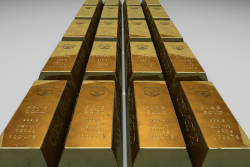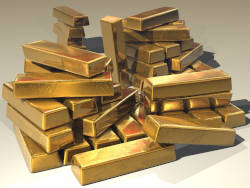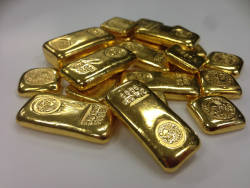Gold Mines




The value of gold is a result of its rareness and also of its interesting physical characteristics. Gold is a so-called precious metal, which means it does not rust (oxidize) at normal conditions. It is resistant to many acids and a good electric conductor, which makes it useful for electronic circuits. It is also useful for jewelry because of its inertness, as it will not oxidize or change in any other way. The continually high value of gold made it an important factor for money. Originally the most valuable coins were made of gold. Later, when people found gold too heavy and difficult to handle, paper money was invented, which was just a sort of paper representation of the gold value. A good example is the British Pound, which originally corresponded with a pound of Sterling Silver. The American dollar was pegged to gold until the 1970s, and you could always exchange its value for gold.
Gold is normally found in pure form. This means it is not oxidized, and it is not necessary to process it very much. But the amounts of pure gold are typically very small as it is normally evenly distributed in the rock. There are several geologic processes which accumulate gold, most important for classic gold fields is erosion. The rock is eroded, the gold remains, and the small pieces of gold are washed into the next stream. But gold is very heavy, and so it tends to deposit in holes on the ground of rivers, a deposit called placer.
Other deposits are poly metallic deposits, where hydrothermal processes, often in combination with sulphuric chemical reactions, deposited large amounts of different metals in submarine depressions or in clefts. Typically gold is the rarest metal in the ore, but depending on the percentage and the value, it may be the most valuable part. As it is rather easy to process those ores in furnaces and separate the different metals, those deposits are mine since the early Middle Ages.
Gold is found all over the world. It is part of any volcanic eruption, though in very small amounts. Depending on the geologic situation, the mining is very different. Modern techniques and the massive use of machinery allows the processing of low grade ores with only very small amounts of gold, some Grammes per ton. Unfortunately, mercury is used to form a mercury-gold amalgam, which can cause massive environmental damage.
The most important gold producer of the World is South Africa. The Kruger Rand gold coins are world-famous. The mines in South Africa can provide several superlatives:
- The Mponeng Gold Mine is the world’s deepest mine, 3585 m below surface.
- The Freegold Mine, owned by an Anglo American corporation, was until recently the world’s most productive gold mine at 115 tonnes per year
- Driefontein Consolidated Mine has produced more gold than any other gold mine, about 2292 tons.
- The deepest single-drop mining shaft in the world has been sunk at the South Deep Gold Mine, owned and operated by Western Areas Gold Mining Company (Johannesburg, South Africa). It is located in Westonaria, Gauteng Province, South Africa. The shaft, with a depth of 2991.45 m below the collar, has taken almost seven years of sinking.
Many gold mines are show mines, because they were closed when they became unprofitable. But there are still ores remaining in many mines. The rising gold price makes some of those mines profitable again. In 2002 the gold price per ounce was around USD 300, in 2005 around USD 700, in 2010 around USD 1,370, and in 2020 over USD 2,000. As a result, many mine owners rethink their decision to close the mines. Numerous have already been reopened.
- Examples
 Tauerngold, Austria
Tauerngold, Austria Zillertaler Goldschaubergwerk, Austria
Zillertaler Goldschaubergwerk, Austria Goldbergbaumuseum Goldkronach, Germany
Goldbergbaumuseum Goldkronach, Germany Mollie Kathleen Mine, CO, U.S.A.
Mollie Kathleen Mine, CO, U.S.A. Tankavaaran Kultakylässä, Finland
Tankavaaran Kultakylässä, Finland
- See also
 Gold mining - Wikipedia (visited: 19-MAY-2022)
Gold mining - Wikipedia (visited: 19-MAY-2022) California Notes, an overview in gold mining techniques by the virtual museum sfmuseum.org. It is an excerpt from
California Notes, an overview in gold mining techniques by the virtual museum sfmuseum.org. It is an excerpt from
Charles Beebe Turrill (1876): California Notes, San Francisco, E. Bosqui & Co., 1876, Chapter X. Links (Akaishi Research Center), gold mining related linklist.
Links (Akaishi Research Center), gold mining related linklist.

 Index
Index Topics
Topics Hierarchical
Hierarchical Countries
Countries Maps
Maps Search
Search